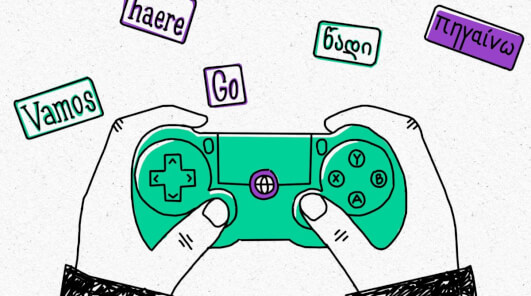
Game Localization: A Strategy to Win New Markets
In recent years, the global gaming industry has experienced rapid growth, becoming one of the largest entertainment sectors worldwide. With thousands of new titles released annually across platforms like PC, console, and mobile, the competition among developers has intensified. This highly competitive landscape demands not only engaging gameplay but also effective strategies to reach new international markets.
One increasingly essential approach is game localization. As gamers come from diverse linguistic and cultural backgrounds, relying solely on English versions is no longer sufficient. Adapting game content to local languages allows for a more personal, relevant, and enjoyable experience for players.
This strategy not only expands a game's reach but also boosts user engagement, loyalty, and revenue potential. As a result, game localization has become a core part of global marketing strategies, especially for developers looking to penetrate fast-growing markets like Indonesia, regions that are witnessing significant increases in gaming populations.
What is Game Localization?
Game localization is the process of bringing all the elements in a game into alignment with the language, culture, and flavor of the customer in a market. In contrast to simply translating content from one language to another, game localization is a total re-tuning that includes cultural context, tone, emotional tone, and overall user experience.
Localization is not limited to in-game scripts alone. Audio material (i.e., voice over and subtitles), UI design, currency displays, units of measurements, date setup, and sometimes even humor or references to region-specific context not necessarily transferable between regions may also need to be changed. Sometimes, names of characters, story or plot elements, or even color are altered for the sake of being well-received by the locals.
Game localization's main task is to provide players with the experience that a game was truly designed for them. Developers have the ability to increase customer satisfaction, engagement, and unlock business potential in new markets, mainly Indonesia and Asia as a whole, by providing users with a feeling of familiarity and inclusiveness.
Why is Localization Essential to Enter New Markets?
In the international gaming competition, localization is not optional but a strategic necessity. Language is the most immediate way to speak to the players. If the game is speaking to the players in their local language, there is an immediate familiarity and trust that gets established. It is more than comprehension; it is emotional identification that can evoke loyalty among players in the long run.
One of the most powerful arguments in favor of localization is that it has been tried and tested in Southeast Asian markets such as Indonesia, Thailand, and Vietnam to massive success. For instance, Mobile Legends: Bang Bang was immensely successful in Indonesia because it fully supported the Indonesian language and included locally relevant content. The game not only localized the interface but also featured regional events, cultural flourishes, and local voice overs that made Indonesian gamers feel heard and appreciated. PUBG Mobile and Free Fire followed suit, taking off in the region as they provided local languages and implemented localized marketing campaigns in each market.
According to Newzoo and Statista statistics, Southeast Asia is one of the world's fastest-growing gaming markets, and Indonesia leads Southeast Asia in player base and mobile gaming revenue. More than 80% of the region's players play games in their native language. This statistic indicates the significance of localization for user reach and retention.
Game localization to the Asian market is translation plus; it is making it more immersive and relevant. By making content relevant to local cultures, developers can make players feel more connected to the experience. This, in addition to aiding engagement, gets players locked in long-term, which, in a competitive market, is essential. As localization is becoming increasingly vital, it's obvious that in order to effectively dominate the market, understanding each territory's unique needs are crucial. This leads us to the most important factors that make game localization really effective, let's find out what makes it successful.
Case Study: Game Localization for Indonesia

Indonesia is one of the largest gaming markets in Asia, with a very high growth rate, especially in mobile gaming. Since most of the internet users in Indonesia access games using mobile devices, mobile-based games are extremely popular among Indonesian gamers. In addition, the eSports market in Indonesia is also booming, with an active community and various tournaments gaining more popularity. All these factors make Indonesia a highly promising market for global game developers.
Successful titles that were localized for Indonesia include Genshin Impact, PUBG Mobile, and Mobile Legends. They became unrivaled in popularity after the Indonesian versions of these games were released. Genshin Impact, for instance, enhanced player experience through the inclusion of Indonesian language, in addition to content optimizations favorable to local culture. Similarly, PUBG Mobile provided not only Indonesian language content but also local market-specific in-game events and updates. Mobile Legends has also emerged as one of the largest mobile games in Indonesia, with regular updates, features, and events that appeal to what Indonesian players desire.
Localization not only enhances the gaming experience but also increases revenue. Players appear to play and pay more for games that appear more intuitive and familiar to them. The presence of Indonesian text, for example, and features emphasizing local culture allows players to connect more with the game world. The immediate effect is higher player retention and loyalty, leading to increased in-game purchases and ad revenue. By grasping the domestic market and carrying out proper localization, developers are able to have tremendous success in Indonesia and build their player base across all of Asia.
Strategic Steps in Game Localization
Localization is a subtle process that entails more than just translation of words into another language. One needs to research the market and culture thoroughly before opting for localization so that the game becomes attractive to the target audience. The following are the key strategic steps to remember while localizing a game for new markets.
- Before localizing, developers must do a lot of market research to understand the target gaming population's specific needs, interests, and purchasing behavior. They must understand the gaming culture, preferred gaming genre, and regional trends that could influence gaming patterns. For example, Southeast Asia is fond of playing MOBA-type games like Mobile Legends, whereas puzzle games could sell more in other regions. In addition, cultural references and sensitivities should be comprehended in order to prevent blunders. Cultural nuances, such as regional humor, folklore allusions, or regional iconography, should be incorporated into the game to ensure smooth and contextually appropriate gameplay for regional players.
- The quality of translation has a direct impact on the playing experience. It is crucial, therefore, to employ target language native speakers as translators and editors. Native speakers not only provide accurate translations but also preserve the tone, idioms, and colloquialisms according to the culture of the place. Professional editors can further calibrate the content so that the language sounds natural and engaging to players in the target market. That avoids the most frequent errors in "robot" translations and further enhances the immersiveness of the game.
- No matter how good translations and culturally acceptable content are, the game has to be tested in the target market before its launch. Playtesting locally is paramount in determining how the game will perform, as well as obtaining valuable criticism for areas where it can improve. During these testing phases, potential bugs, user interface issues, or play issues can be found that may not have appeared during development. Playtesting enables developers to incorporate changes from actual feedback and hone the game for a better player experience.
- Localization is not just words, it's creating an experience that's local to where it's being played. Adding in-game events that represent regional holidays, festivals, or mainstream local sports can help to engage players. As an example, a festive mode for Lunar New Year in China or Hari Raya in Indonesia can increase the interest of the game with players. Voice over localization is also a required process to consider, especially for more interactive games with narratives. Presenting the voice acting in the local language and accents adds authenticity to the game. Finally, enabling local payment options is essential in regions where digital payments are vastly different. Allowing players to use payment systems familiar to them, like local e-wallets or mobile payment operators, will allow transactions to be more streamlined and drive spending within the game.
Challenges in Game Localization and How to Overcome Them
Localization does not come without complications, and understanding the probable complications is essential to having a successful transition into new markets. They can be technical, cultural, or even worries about maintaining the integrity of the game while adjusting it for the local market.
- One of the most daunting challenges in game localization is ensuring that the content of the game is appropriate to both the technical and cultural requirements of the target market. Different regions may have different text length standards, UI layouts, or even character design. For instance, certain characters or symbols might be considered offensive in certain cultures, and the game may need adjustments to ensure it does not offend local sensibilities. Additionally, technical issues such as encoding, font compatibility, and the integration of localized assets without compromising the game's performance are common obstacles that require planning and expertise.
- In order to overcome these technical challenges, developers can use automated software such as machine learning-based translation tools and translation management software to accelerate the process. However, while these automated tools may streamline the technical part, high-level cultural adaptation still needs human knowledge. Work with local translators and agencies familiar with the marketplace bridges the gap between basic translation and culturally appropriate content. This collaboration ensures the translation is linguistically and culturally appropriate.
- Another major challenge is maintaining the core identity of the game while localizing it. It's crucial to keep the original game's identity, its humor, tone, and gameplay intact, while ensuring that it appeals to local players. This is a delicate balance that needs to be achieved through collaboration between developers and local experts to ensure that the game's unique elements, like jokes, references, or gameplay mechanics, still sound natural while being culturally appropriate. In conclusion, game localization is an essential strategy for reaching new markets and expanding a game’s global presence. By adapting the content to fit the language, culture, and preferences of local players, developers can significantly enhance player engagement and loyalty. Although the process presents challenges ranging from technical adjustments to cultural nuances. The right strategies, tools, and partnerships can overcome these obstacles. Ultimately, successful game localization not only improves the player experience but also drives growth in new markets, making it a key component of a game’s global success.
Ready to conquer new gaming markets with expert localization? Visit https://digital-trans.asia/ to learn more about our services. Contact us today to get started!